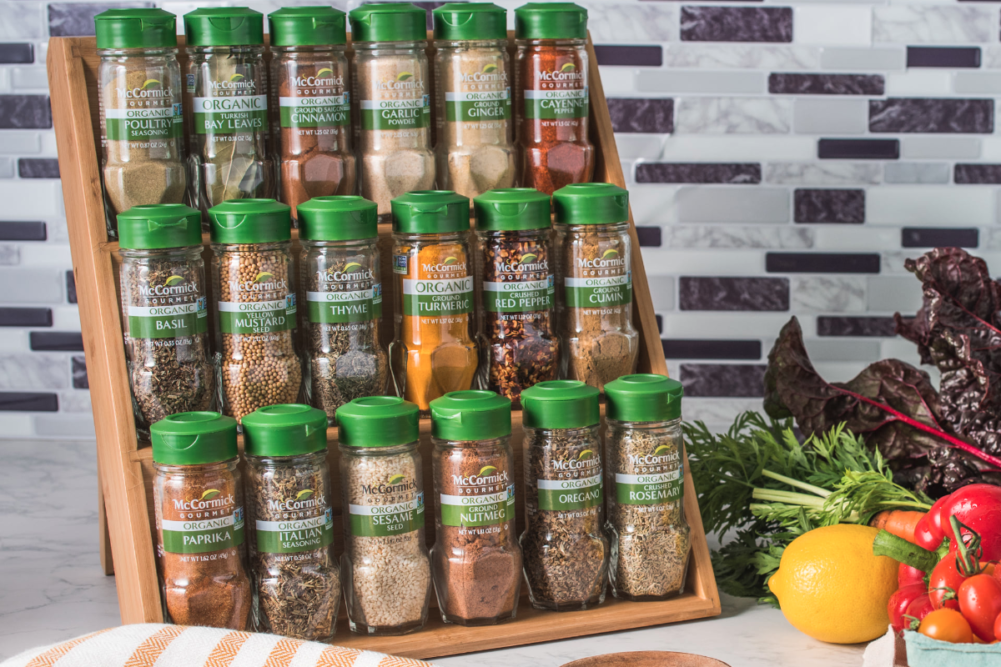HUNT VALLEY, MD. – Elevated at-home food and beverage demand due to the coronavirus (COVID-19) has had a positive impact on most consumer package goods companies. As manufacturers begin to lap that elevated demand next year, financial analysts are asking how it may affect company performance. Executives with McCormick & Co. see demand moderating but remaining elevated well into the year.
Information Resources, Inc., data cited by management during a conference call with securities analysts Sept. 29 to discuss third-quarter results showed at-home demand in the United States was up 55% in the second quarter of 2020. As 2020 has progressed at-home has remained up over 20% year-over-year.
“And as we go through the fourth quarter, we’re ramping up capacity, but that’s really meeting demand,” said Lawrence E. Kurzius, chairman, president and chief executive officer, during the call. “The real rebuild of shelf stock, of retailer safety stock, inventory in the whole — the normal level of inventory in the trade pipeline, that rebuild is going to happen next year. And well, it’s going to take well into the year to get that back up.”
Mr. Kurzius admitted there will be some “tough comparisons” next year, but restocking the supply chain will act as a tailwind even if at-home consumption moderates further. Another boost to demand may be new product introductions originally scheduled for the second half of 2020, but deferred to 2021.
“I don’t think our experience in that area is much different than what others set up, but we also had a big shelf initiative,” Mr. Kurzius said. “We had a spice aisle reinvention program that we unveiled at CAGNY and had a plan to get into thousands of stores. … We have made that change in thousands of stores, but nowhere near to the magnitude that we expected. And so that’s also going to be a part of the program for next year.”
The seasoning, spice and condiment maker’s third-quarter results benefited from more consumers eating at home more often. Net income for the quarter ended Aug. 31 totaled $206 million, equal to $1.55 per share on the common stock, and in increase over the same period of the previous year when the company earned $192 million, or $1.45 per share.
Quarterly sales rose 9% to $1.4 billion.
“In our Consumer Segment around the world, we are experiencing strong sustained consumer demand, which is real incremental consumption and reflects the trend of consumers cooking more at home,” Mr. Kurzius said. “In China, which is viewed as a leading indicator since their COVID-19 recovery is ahead of the rest of the world, the demand for food at home continues to be very strong. We see the same in Europe and of course, in the Americas. The significant shift to consumers eating more at home is persisting long enough that it has become a habit.”
Consumer Segment sales rose 15% to $911 million during the quarter. Business unit operating income increased 18% to $209 million. The year-over-year operating income growth was driven by the favorable impact of higher sales and cost savings with a partial offset from COVID-19 related costs as well as increased incentive compensation.
Flavor Solutions business unit sales, which represent the company’s foodservice efforts, fell 3% to $519 million. Operating income fell 24% to $64 million. Mr. Kurzius said the Flavor Solutions business is seeing “varying stages of recovery” around the world.
“Starting with the away-from-home portion of the segment, with our quick-service restaurant customers or QSRs, we are seeing strong signs of recovery,” he said. “Their business models were already oriented to drive-thru or carry-out, not dining in. In China, QSR traffic has returned to near-normal levels, and limited-time offers and promotions are driving demand. In the rest of the APZ region as well as EMEA and Americas, the focus has been on core menu items.”
In other parts of the foodservice market the pace of recovery is much slower, Mr. Kurzius said.
“We expect the recovery in this area of the business to be more gradual and take time, likely years, as restaurants and other foodservice venues, such as stadiums and cafeterias, continue to be largely closed or operating under capacity limitation,” he said. “Consumers are reluctant to dine out, and the restaurant industry has experienced significant pain.”
The company withdrew its fiscal 2020 guidance this past March, but reinstated it starting with the fourth quarter of fiscal 2020.
“We expect to grow sales at the upper end of a 4% to 5% range, which in constant currency is in the range of 5% to 6%,” said Michael R. Smith, chief financial officer. “This increase is expected to be entirely organic and reflects growth driven by new products, expanded distribution, brand marketing and pricing, which in conjunction with cost savings, is expected to offset anticipated mid-single-digit inflationary pressures. It includes the net impact of the shift in demand due to COVID-19 and the consumer's sustained preference for cooking at home.”
Adjusted operating income is expected to grow 5% to 6% on a constant currency basis.
“This includes our cost savings targets of approximately $105 million and an expected mid-single-digit increase of brand marketing investments,” Mr. Smith said.





